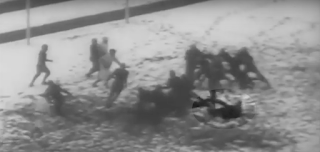Amazingly, in the six years I’ve done this little ol’ blog, I have yet to write about one of the more legendary teams in New England football annals — the 1940 Boston College team that went undefeated and claimed (and still claims) a share of the national championship (more on that later). Which is kind of odd, considering one of my early posts was on the 1939 bunch that went 9-2 and lost to future ACC rival Clemson in the Cotton Bowl.
As noted in that long-ago post, the ’39 Eagles, under coach Frank Leahy, introduced the basic uniform template — gold helmets and pants, maroon or white jersey — that continues to this day. The 1940 team wore similar uniforms, except for an odd-looking outfit against Temple with something more along the line of practice jerseys (check out the stenciled numbers!). As far as I know, they were worn only once.
 |
| Boston College (in white) hosts Temple at Fenway Park. Note the stenciled numbers on the jerseys. |
The 1940 team was the most celebrated in program history, well, until Jesus-in-cleats came along in early ‘80s. 😎 There’s plenty of info on this team out there, so I’ll try to sum it up in 10 points.
- Defeated “powerhouses” Centre, Idaho, St. Anselm and Manhattan (actually, Manhattan was a pretty decent program in the ‘30s, believe it or not) in the early part of schedule and also beat an OK Tulane team in New Orleans.
- Edged an outstanding Georgetown team (yes, you read that right), 19-18 at Fenway Park in a battle of undefeated teams. The Hoyas finished 8-2 and No. 13 in the final Associated Press poll.
- Crushed Auburn, another decent SEC team that finished 6-4-1, 33-7.
- Beat a mediocre Holy Cross team, 7-0, in the regular season finale.
- Finished No. 5 in the final AP poll, released before the bowl games.
- Stunned undefeated SEC champion and No. 4 Tennessee 19-13, on a 24-yard QB draw TD run by quarterback “Chuckin’” Charley O’Rourke in the fourth quarter.
- O’Rourke and four other Eagles from this team are in the College Football Hall of Fame.
- End Gene Goodreault was a consensus All-American. Mike Holovak later coached BC and the Patriots, with fair success. Another Eagle, Joe Zabilski, was later a longtime coach and administrator at Northeastern.
- Coach Leahy, who went 20-2 in two years at BC, left for Notre Dame, where he won about a gazillion national titles and about as many Heisman Trophy winners.
- Boston College claims a national title for this team despite point No. 5.
 |
| Boston College (in dark jerseys) shocks Tennessee in the 1941 Sugar Bowl. |
It’s that last point that fascinated me for years. I remember first seeing the national title claim in a football book when I was younger, in a chapter on Leahy by someone who was clearly a starry-eyed Leahy fan, since the topic of the book was … the American Football League. (Leahy was the L.A. Chargers’ general manager their first year, and one of his disciples, Billy Sullivan, was the original owner of the then-Boston Patriots, but otherwise, Leahy’s AFL connection is rather spurious, at best.)
 |
| Boston College's 1940 title banner, snapped by yours truly at a game several years ago. |
I salted the BC title nugget away for years, then unearthed it when I came across a 1940 poll (this is before the interwebs, kiddies) that had BC at No. 5, behind (in order) Minnesota, Stanford, Michigan and Tennessee (remember, this is a pre-bowl poll). Being more jaded by this time, I figured the national title claim was a bogus claim Boston writers and fanboys made in the afterglow of the big Sugar Bowl win, and I still felt that way until recently.
 |
| A scene from the win over Holy Cross. Note the snowbanks in front of Fenway's center-field wall. |
TipTop 25 (I know it seems I can’t go a post without referencing this site, but it’s addictive for anyone with even a passing interest in the game’s history), which attempts to fix the AP polls from 1936 to today and creates “polls” from 1901-35, compares the 1940 campaigns on BC, Minnesota and Stanford at great length. The ruling from the replay booth … Minnesota and Stanford are the top two teams, but BC has a legit claim to the title based on the Tennessee win, which TipTop proclaims the biggest win of the year by any team, and compensates for BC having only two wins over ranked teams, compared with five for Minnesota and three for Stanford. They cover it in far more detail than I can, so click on the link and read for yourself.
So there you have it. BC’s national title claim is no pile of eagle feathers, and the school can continue to fly that 1940 title banner, guilt-free.
 |
| BC running back Lou Montgomery, the first African American to play for the Eagles. Alas, segregation laws kept him from playing in the 1940 Cotton Bowl, the '41 Sugar Bowl and even the 1940 Auburn game, even though it was in Boston. Reid Oslin's Tales From the Boston College Sideline discusses Montgomery's sad story in greater detail. |













































